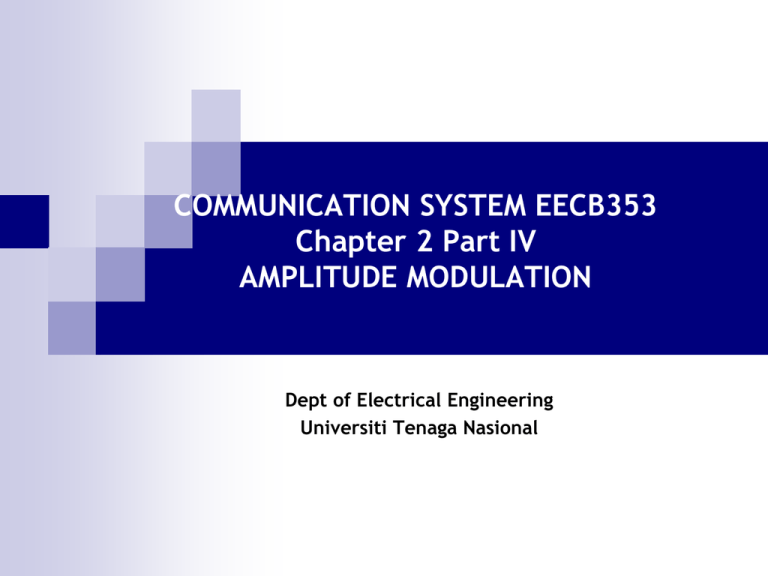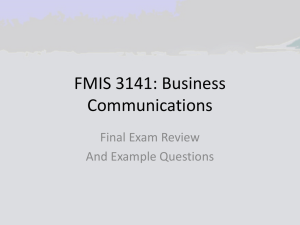Chapter 2 part IV_updated 23 july - MetaLab
advertisement

COMMUNICATION SYSTEM EECB353 Chapter 2 Part IV AMPLITUDE MODULATION Dept of Electrical Engineering Universiti Tenaga Nasional Superhetrodyne Receiver Superhetrodyn receivers convert all incoming signals to a lower frequency, known as the intermediate frequency (IF), at which a single set of amplifiers is used to provide a fixed level of selectivity and sensitivity. The key circuit is the mixer – act as a simple amplitude modulator to produce sum and difference frequencies. Heterodyne means to mix two frequencies together in a nonlinear device or to translate one frequency to another using nonlinear mixing. 2 Superhetrodyne Receiver AM Non-Coherent Superhetrodyne Receiver Block Diagram 3 Superhetrodyne Receiver fLO should always be at a freq 455kHz above the incoming carrier freq., fc When the freq of LO is tuned above RF : High side injection fLO = fRF + fIF When the freq of LO is tuned below RF : Low side injection fLO = fRF - fIF 4 Superhetrodyne Receiver RF Section Consist of pre-selector and RF amplifier Pre-selector is a broad-tuned BPF with an adjustable centre frequency that is tuned to the desired carrier frequency. Main purpose of the pre-selector is by selectivity, it accepts only the desired frequency or prevent unwanted radio frequency (Image Frequency) from entering the receiver and all others are rejected. RF Amplifier – to amplify the signal before entering the mixer 5 Superhetrodyne Receiver Mixer/Converter Section This section includes a radio frequency oscillator stage (LO) and a mixer/converter stage (the first detector) which is a nonlinear device used to convert RF’s to IF’s (RF to IF frequency translation). IF signal in commercial AM broadcast are between 450kHz and 460kHz. The most common IF used is 455kHz. Reason to translate RF ->IF is to obtain adequate selectivity. -RF signal are down converted to IF. -Shape of the envelope remains the same, although the carrier and SBs freq are translated from RF->IF, the original info contained in the envelope remain unchanged. 6 Superhetrodyne Receiver Mixer/Converter Section LO is always maintained at a frequency which is higher, by a fixed amount, than the incoming RF signals. The mixer in the receiver combines the signal from the RF amplifier and the frequency input from the local oscillator to produce three frequencies: A ‘difference’ frequency of local oscillator frequency - RF signal frequency. A ‘sum’ frequency equal to local oscillator frequency + RF signal frequency. A component at the local oscillator frequency. Mixing two signals to produce such components is called a ‘heterodyne’ process. 7 Frequency Conversion Concept of a mixer. Frequency Conversion Process Difference component: 1455-(999,1000,1001)kHz All original inputs Sum component: 1455+(999,1000,1001)kHz Consider a situation shown above. The AM signal into the mixer is a 1000kHz carrier that has been modulated by a 1kHz sinewave, thus producing side freqs at 999 kHz and 1001 kHz. 9 Frequency Conversion Process The IF amplifier has a tuned circuit that accepts components only near 455kHz, in this case 454kHz, 455kHz and 456kHz. Since the mixer maintains the same amplitude proportion that existed with the original AM signal input at 999kHz, 1000kHz and 1001kHz, the signal now passing through the IF amplifiers is a replica of the original AM signal. The only difference is that now its carrier freq is 455kHz. A frequency conversion has occurred that has translated the carrier from 1000kHz to 455kHz – a frequency intermediate to the original carrier and intelligence frequencies. 10 Mixer Output 460kHz 455kHz 450kHz 545kHz 550kHz 555kHz 1005kHz 1550kHz 1555kHz 1560kHz 11 Superhetrodyne Receiver How LO tracks the RF amplifier so that the difference between the two frequencies is maintained at a constant value? Example – the radio is tuned to received a broadcast station which transmit at 800kHz. The LO will be running at 1255khz. The difference frequency is 1255kHz – 800kHz = 455kHz. A Superhetrodyne Receiver Tuned to 800kHz 12 Superhetrodyne Receiver Similarly if the radio is tuned to received a station transmitted at 700kHz The LO will be running at 1155kHz and the difference is still maintained at the required 455kHz. This frequency difference therefore remain constant regardless of the frequency to which the radio is actually tuned and is called the intermediate frequency (IF). When the freq of LO is tuned above RF : High side injection fLO = fRF + fIF When the freq of LO is tuned below RF : Low side injection fLO = fRF - fIF 13 Example 1 AM superhetrodyne receiver using high-side injection, with LO freq of 1355kHz. Determine the IF carrier, upper side freq and lower side freq for an RF wave that is made up of a carrier and upper and lower side freq of 900kHz, 905kHz and 895kHz respectively. 14 15 Image Frequency Previously, for a 700kHz broadcast station, the LO of 1155kHz giving the difference (IF) frequency of the required 455kHz. What happen if we were to receive another station broadcasting on a frequency of 1610kHz? This would also mix the LO freq of 1155kHz to produce the IF freq of 455kHz. i.e this station also received the same time as one at 700kHz. Station 1: Frequency 700kHz, LO 1155kHz, IF = 455kHz Station 2: Frequency 1610kHz, LO 1155kHz, IF = 455kHz An Image Frequency is an unwanted frequency that can also combine with the LO output to create the IF frequency. 16 Image Frequency (fim) An image freq is any freq other than the selected radio freq carrier that if allowed to enter a receiver and mix with the LO, will produce a cross-product freq that is equal to the IF. An image freq is equivalent to a second RF that will produce an IF that will interfere with the IF from the desired RF. Once an image freq has been mixed down to IF, it cannot be filtered out or suppressed. For RF to produce a cross product equal to the IF, it must be displaced from the LO freq by a value equal to the IF: f im f LO f IF For high-side injection: Giving: f RF f IF f LO f im f RF 2 f IF 17 Image Frequency (fim) Figure : Relative Frequency Spectrum for the RF, IF, LO and Image Frequencies for a superhetrodyne receiver using High-side Injection Example 2- Determine the image frequency for a standard broadcast AM receiver tuned to a station at 1320kHz. 18 Example 3 For a citizen band receiver using high side injection with an RF carrier of 27 MHz and IF center frequency of 455 kHz, determine : i- Local oscillator frequency ii- Image frequency 19 Superhetrodyne Receiver IF Section Consists of a series of IF amplifiers and BPFs These stages contain most of the amplification in the receiver as well as the filtering that enables signals on one frequency to be separated from those on the next. Most of the receiver gain and selectivity is achieved in the IF section. Detector Section Convert the IF signals back to the original source information. Audio Amplifier Section Comprises several cascaded audio amplifiers and one of more speakers. The number of amplifiers used depends on the audio signal power desired. 20 Automatic Gain Control Circuit (AGC) The AGC circuit is used to prevent very strong signals from overloading the receiver. It can also reduce the effect of fluctuations in the received signal strength. The AGC circuit makes use of the mean DC voltage level present at the output of the diode detector. If the signal strength increase, the mean DC voltage level also increase. If the mean DC voltage level exceeds a predetermined threshold value, a voltage is applied to the RF and IF amplifiers in such a way as to decrease their gain to prevent overload. As soon as the incoming signal strength decreases, the mean DC voltage level is reduced below the threshold, the RF and IF amplifiers return to their normal operation. 21 Automatic Gain Control Circuit (AGC) 22 Exercise – Midterm Sem II 07/08 A radio station transmits using AM at a carrier frequency of 600 kHz. The AM band frequencies are allocated with a separation of 9 kHz. The AM signal is received by means of a superhetrodyne receiver with an intermediate frequency of 455 kHz. Calculate: i. The highest possible modulating frequency. ii. The local oscillator frequency. iii. The image frequency. iv. Draw the block diagram of the receiver used at the station and list all the frequency components before and after the heterodyning process. 23










